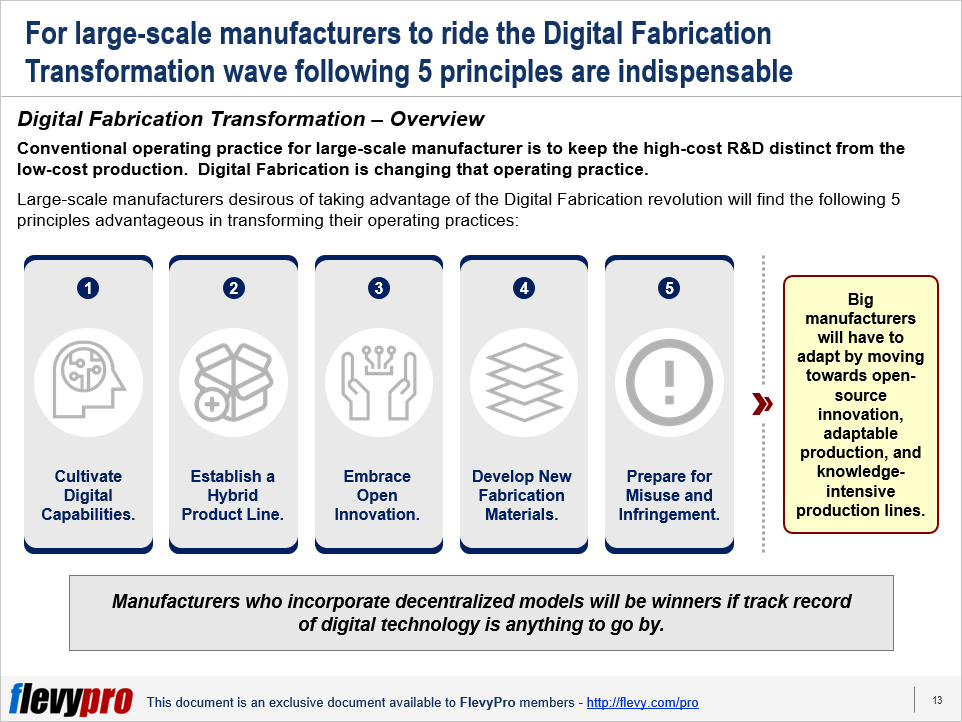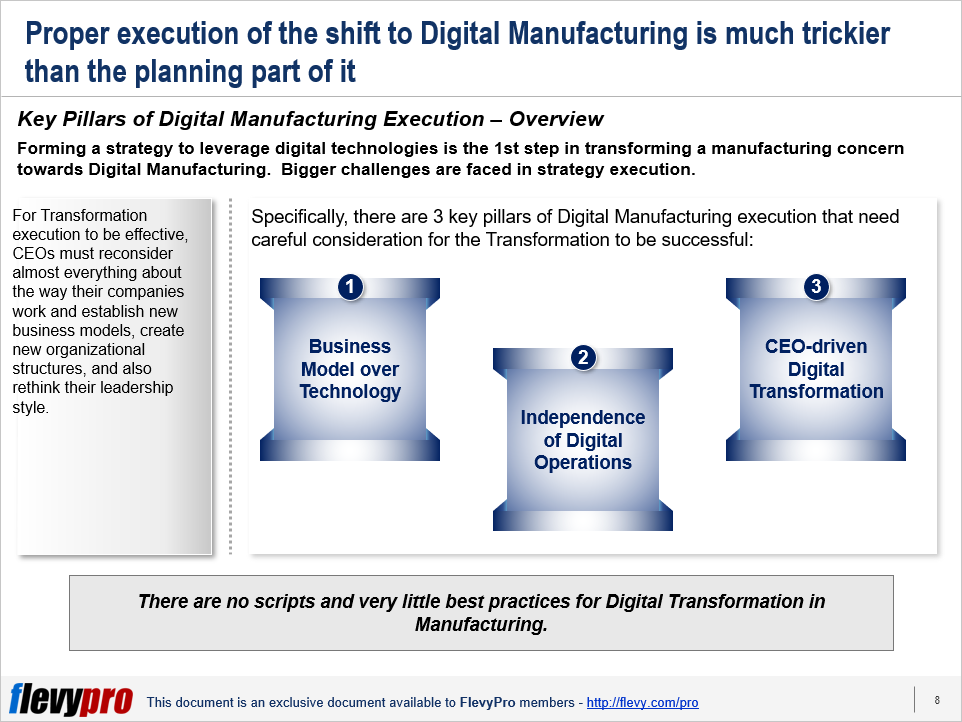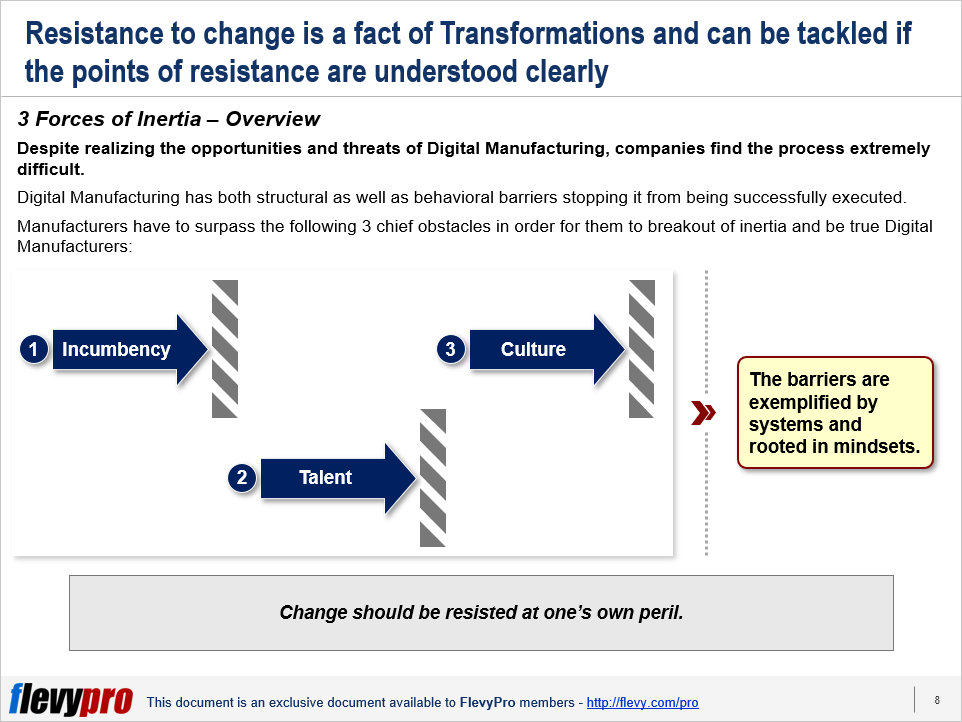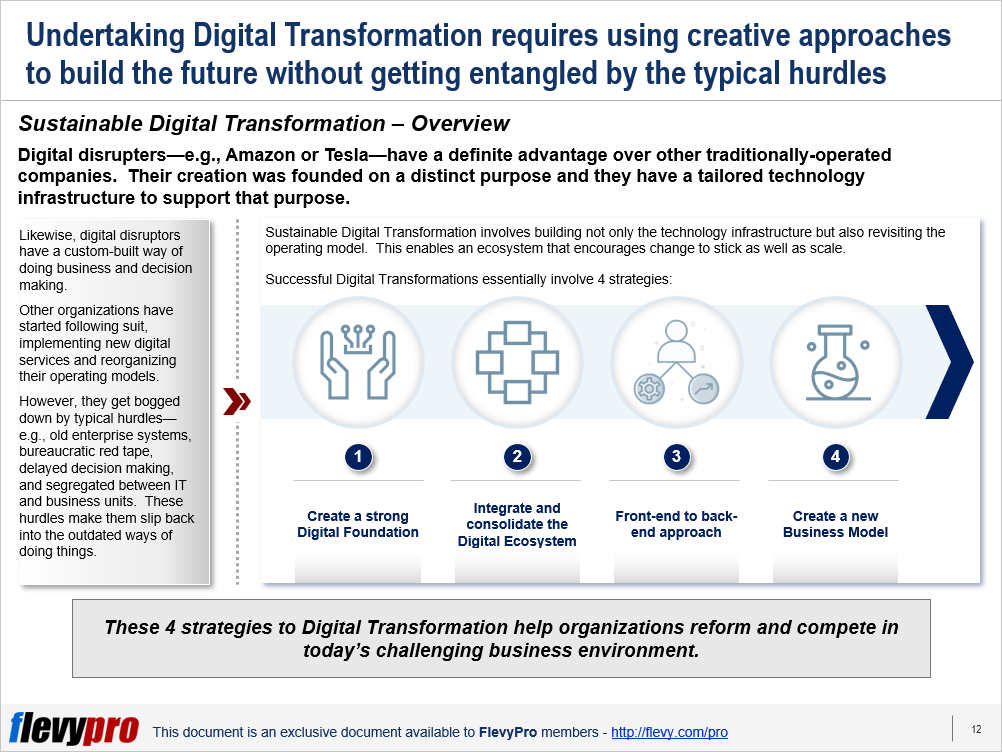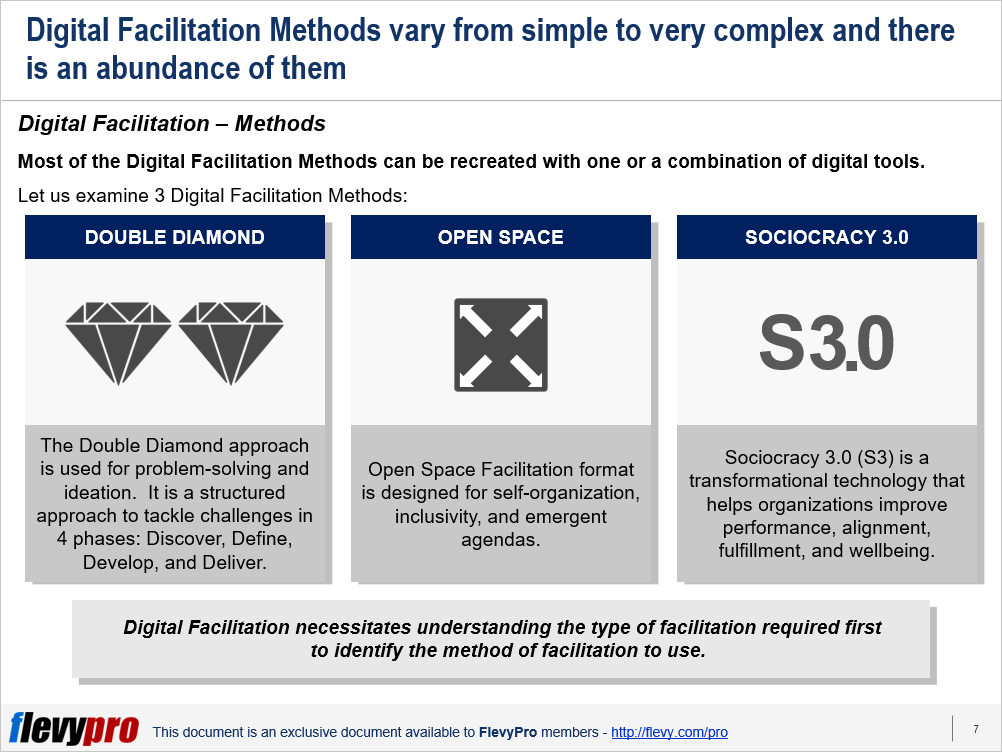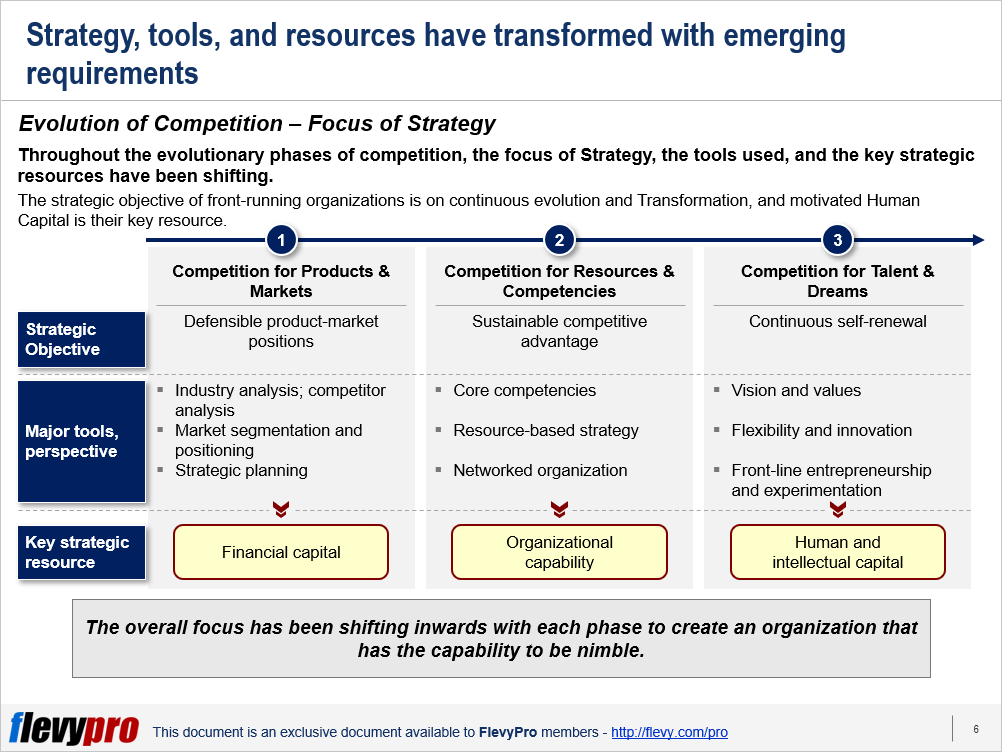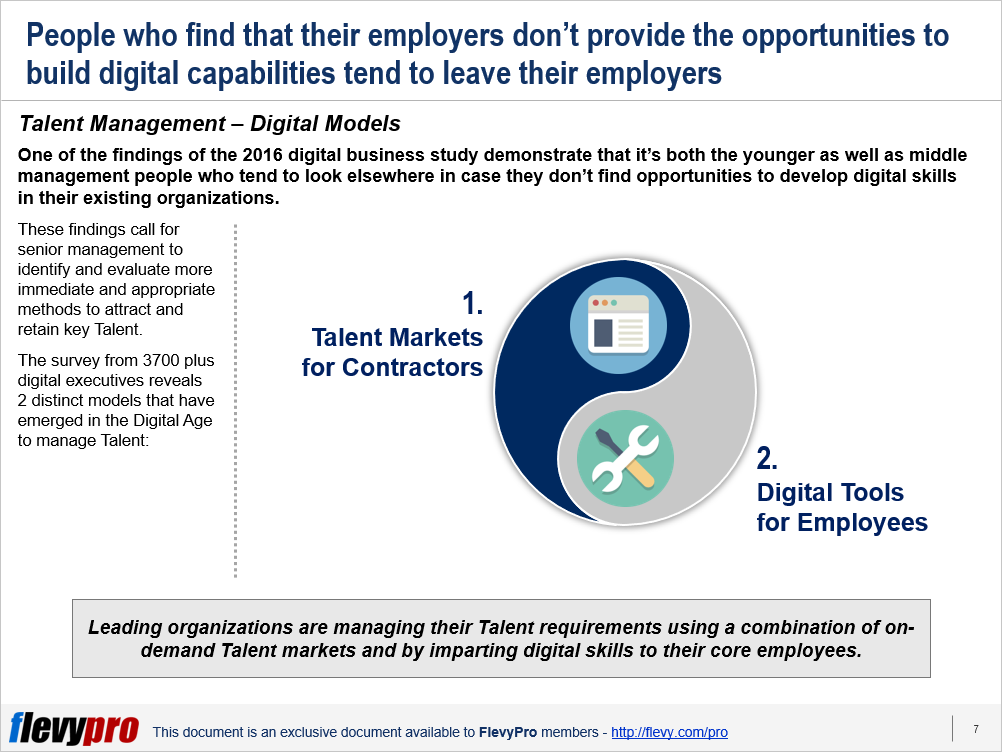Digital Fabrication: Manufacturing Transformation
6 Dec

Editor’s Note: If you are interested in becoming an expert on Supply Chain Management (SCM), take a look at Flevy’s Supply Chain Management (SCM) Frameworks offering here. This is a curated collection of best practice frameworks based on the thought leadership of leading consulting firms, academics, and recognized subject matter experts. By learning and applying these concepts, you can stay ahead of the curve. Full details here.
The conventional Business Model for Manufacturing is in the process of Transformation. Centralized production has given way to dispersed manufacturing that is customized. Conventional operating practice at large-scale manufacturers is to keep the high-cost R&D distinct from the low-cost production. Digital Fabrication is changing this operating practice.
More and more Digital Fabrication Tools are being developed and used every day which is laying the foundation for Digital Transformation revolution. These tools are being used to develop customized end-products by small-scale manufacturers and in some cases single-person manufacturing concerns. Digital Fabrication tools may be 1 of the following 2 types:
- Programmable Subtractive Tools—designed to carve shapes from raw materials. Examples of such tools include laser cutters, CNC routers and milling machines, plasma or water jet cutters.
- Additive Rapid Manufacturing Tools—which are predominantly computer-operated 3-D printers that chiefly construct objects layer by layer but may also be designed to use laser or electron beams.
The impact of the community of individuals dealing in Digital Fabrication tools in disrupting the conventional manufacturing model, is more than the tools themselves. The community is, essentially, a self-established, worldwide Supply Chain, involving quite a few interconnected setups, user clusters, cybershopping sites, and social media environments.
The creators have fashioned open-source collaborations that leverage dropping costs of Digital Fabrication and current social media connectedness. Distributed manufacturing networks allow customers to post job requests that can be taken up directly by fabricators.
In the fabricator-culture, individuals are supposed to make their plans and specifications public, usually under an open-source license, which permits anyone to replicate, adapt, and learn from the designs; always giving credit to the creators and common access to ideas. Collaborators share information mutually, assist each other in progressing, and nothing is owned or controlled centrally. Accessible repositories allow creators to trade plans and instructions, align production, and sell their designs and fabricated articles straight to the society.
Considered holistically, Digital Fabrication and information sharing is ushering in a broadening of the manufacturing environment.
Big manufacturers will have to undergo Business Transformation by adopting open-source innovation, adaptable production, and knowledge-intensive production lines in order to move towards Digital Manufacturing. Large-scale manufacturers desirous of taking advantage of the Digital Fabrication Transformation will find the following 5 principles indispensable in transforming their operating practices:
- Cultivate Digital Capabilities.
- Establish a Hybrid Product Line.
- Embrace Open Innovation.
- Develop New Fabrication Materials.
- Prepare for Misuse and Infringement.
Digital Fabrication’s effect on manufacturing has been similar to that of the internet on information-centric solutions and services or like video content platforms’ effect on television networks.
Let us delve a little deeper into some of the principles.
Cultivate Digital Capabilities
Investing in technology that enables the business to make part of the product portfolio using printable composites, in a back room, will give it a Competitive Advantage.
Gaining Digital Fabrication skills and experience now will set the launch pad for leveraging when the time is right.
Establish a Hybrid Product Line
Start a product line that is mixed—with corresponding mass-production and individual-production articles. New feature substitution, alteration in production line, or restarting production of old products can easily be achieved with Digital Fabrication tools, at a profit.
Certain commonly used products that are consumed in large quantities are better off produced on large scale.
Embrace Open Innovation
Offset reverse engineering and modification culture being driven by the ease of Digital Fabrication with Open Innovation.
Interested in learning more about Digital Fabrication Transformation? You can download an editable PowerPoint on Digital Fabrication Transformation here on the Flevy documents marketplace.
Want to Achieve Excellence in Supply Chain Management (SCM)?
Gain the knowledge and develop the expertise to become an expert in Supply Chain Management (SCM). Our frameworks are based on the thought leadership of leading consulting firms, academics, and recognized subject matter experts. Click here for full details.
Supply Chain Management (SCM) is the design, planning, execution, control, and monitoring of Supply Chain activities. It also captures the management of the flow of goods and services.
In February of 2020, COVID-19 disrupted—and in many cases halted—global Supply Chains, revealing just how fragile they have become. By April, many countries experienced declines of over 40% in domestic and international trade.
COVID-19 has likewise changed how Supply Chain Executives approach and think about SCM. In the pre-COVID-19 era of globalization, the objective was to be Lean and Cost-effective. In the post-COVID-19 world, companies must now focus on making their Supply Chains Resilient, Agile, and Smart. Additional trends include Digitization, Sustainability, and Manufacturing Reshoring.
Learn about our Supply Chain Management (SCM) Best Practice Frameworks here.
Do You Find Value in This Framework?
You can download in-depth presentations on this and hundreds of similar business frameworks from the FlevyPro Library. FlevyPro is trusted and utilized by 1000s of management consultants and corporate executives. Here’s what some have to say:
“My FlevyPro subscription provides me with the most popular frameworks and decks in demand in today’s market. They not only augment my existing consulting and coaching offerings and delivery, but also keep me abreast of the latest trends, inspire new products and service offerings for my practice, and educate me in a fraction of the time and money of other solutions. I strongly recommend FlevyPro to any consultant serious about success.”
– Bill Branson, Founder at Strategic Business Architects
“As a niche strategic consulting firm, Flevy and FlevyPro frameworks and documents are an on-going reference to help us structure our findings and recommendations to our clients as well as improve their clarity, strength, and visual power. For us, it is an invaluable resource to increase our impact and value.”
– David Coloma, Consulting Area Manager at Cynertia Consulting
“FlevyPro has been a brilliant resource for me, as an independent growth consultant, to access a vast knowledge bank of presentations to support my work with clients. In terms of RoI, the value I received from the very first presentation I downloaded paid for my subscription many times over! The quality of the decks available allows me to punch way above my weight – it’s like having the resources of a Big 4 consultancy at your fingertips at a microscopic fraction of the overhead.”
– Roderick Cameron, Founding Partner at SGFE Ltd













